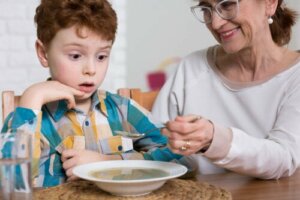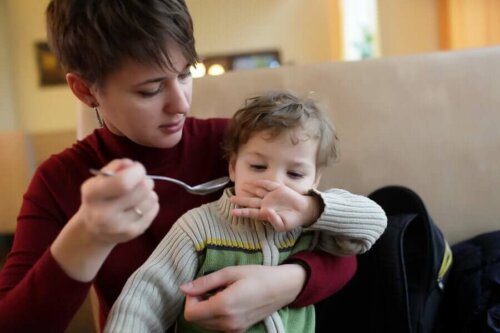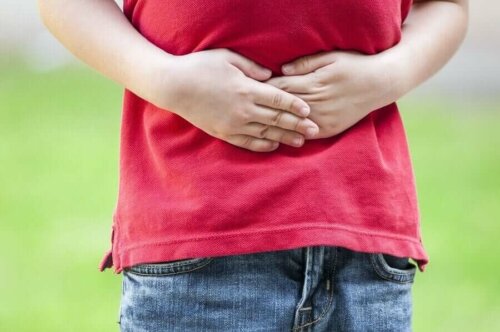Eating Disorders in Autistic Children


Written and verified by the nutritionist Anna Vilarrasa
Eating disorders in autistic children are common. They can have many causes, although they’re generally secondary to the characteristic alterations of this disorder. They often have varying degrees of intensity.
Keep in mind that autism spectrum disorders (ASD) are a group of disorders of the central nervous system that affect brain function. Its onset is usually during childhood and problems in neuronal functioning translate into difficulties in the areas of social interaction and communication skills.
Factors associated with eating disorders in autistic children
The area of eating is often affected in autistic children. Its causes have to do with the following:
- Alterations in sensory perception, which result in hyposensitivity or hypersensitivity to certain textures, flavors, smells, or colors
- Limited interests
- Repetitive behavior
- Can’t fully integrate sensory perceptions
Thus, autism can impact a child’s diet in several ways. Continue reading to find out what the main eating disorders are in children with this condition.
Discover The Five Most Common Signs of Autism
Main eating disorders in autistic children

1. Limited diet
Due to the limited selection of foods, and the strong aversions that some of them can arouse, the diet of children with autism can be limited. They may reject specific foods, an entire group, foods with a certain color or texture, and so on.
They also tend to have a preference for one type of preparation or presentation. In general, and without it being the norm, autistic children tend to favor red, yellow, or orange food and usually reject grainy, viscous, and astringent textures.
2. Not eating enough
Children with autism have trouble focusing on a single task for long periods of time. Therefore, it’s difficult for them to sit at a table through an entire meal.
Added to the restrictive food choices factor we mentioned above, their diets end up being insufficient in terms of energy and nutrients.
In addition, there may be difficulty establishing the roles of power and acceptance of imposed limits. Thus, it’s the children who take full control of their eating, as they choose what to eat, what not to eat, and in what quantities.
3. Food aversions caused by negative classical conditioning
Classical conditioning is the existence of a stimulus-response that happens as a result of an experience. As a result, it’s common for autistic children to have an aversion and reject certain types of food if their previous experience with it was negative.
Negative experiences could be:
- Abdominal pain, vomiting, diarrhea, etc
- Discomfort generated by anger or a struggle about eating
In addition, their negative memory can be extended to similar foods and this reduces the variety of food they’re willing to eat.

4. Medication-related problems
Some of the medications used for treating autism spectrum disorders (ASD) have an impact on children’s diets. They may cause a decrease or increase in their appetite and can prevent the absorption of some vitamins and minerals.
This is why it’s important to know the side effects of the treatments and discuss them with the professionals who work with the autistic child.
5. Frequent digestive upset
Autistic children often have some symptoms related to the digestive system and food. These include:
- Abdominal pain
- Pyrosis (heartburn)
- Chronic diarrhea or constipation
- Regurgitations
- Flatulence
- Vomiting
In any case, you should realize that the appearance of these symptoms isn’t caused by autism, but by the eating disorders that derive from it.
For example, restricting some fruit and vegetables could lead to diets that are low in fiber. Thus, the child is likely to develop constipation problems. They’ll also end up with chewing difficulties and a deficit that’ll lead to poor digestion and flatulence.
However, you must pay attention to the frequency and intensity of symptoms. You should assess the possible existence of an allergy or food intolerance, because these are very common during childhood.

Read more: Research Discovers Physical Characteristics Linked to Autism
Intervention in the eating disorders of autistic children
You must take immediate action when faced with an eating disorder in a child, especially if they’re autistic. Perhaps you don’t consider it a priority, but nutritional deficiencies during childhood often lead to malnutrition.
This is an added problem for a child’s proper development and growth. A meta-analysis of scientific studies found that the diets of autistic children contain less protein and calcium than those of “normal” children.
Thus, you must address any food problems your child may have in order to find an adequate solution for them. In addition, specialists highlight the need for a diet adapted to every child (adapting to their preferences) and to maintain control of their nutritional status.
Only this way can they improve their eating habits and prevent possible future problems related to a poor diet.
Eating disorders in children with autism require attention
Finally, it’s essential to address eating disorders in autistic children in a timely manner in order to avoid complications during their development. Thus, any eating disorder is a reason to consult a pediatrician, nutritionist, or other medical professionals.
Thanks for reading.
All cited sources were thoroughly reviewed by our team to ensure their quality, reliability, currency, and validity. The bibliography of this article was considered reliable and of academic or scientific accuracy.
- Ansel K. Autism Spectrum Disorders and Diet. Abril 2019. American Academy of Nutrition and Dietetics.
- Baratas M. et al. Guía de Intervención ante los trastornos de alimentación en niños y niñas con trastorno del espectro del autismo (TEA). Federación Autismo Madrid.
- Kawicka A, Regulska-Illow B. How Nutritional Status, Diet and Dietary Supplements Can Affect Autism. A Review. Rocz Panstw Zakl Hig. 2013;64(1):1‐12
- Sharma S.R, et al. Autism Spectrum Disorder: Classification, diagnosis and therapy. Pharmacology and Therapeutics. Octubre 2018. 190;91-104.
- Sharp W, et al. Feeding Problems and Nutrient Intake in Children with Autism Spectrum Disorders: A Meta-analysis and Comprehensive Review of the Literature. Journal of Autism and Development Disorders. 2012. 43;2159-2173.
This text is provided for informational purposes only and does not replace consultation with a professional. If in doubt, consult your specialist.








